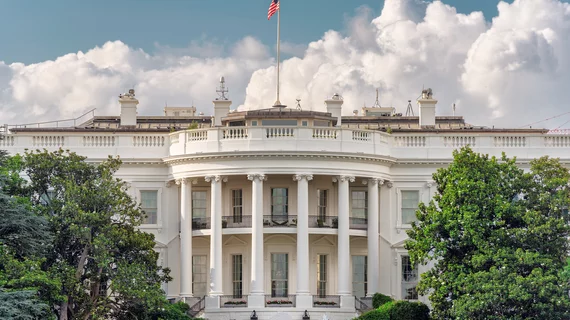What the Biden administration’s artificial intelligence executive order means for radiology
A new artificial intelligence executive order from the Biden administration has some key implications for radiology, according to a new review published Thursday in JACR [1].
The White House issued the “landmark” document in October, aimed at ensuring America leads the way in seizing the promise, and the managing risks, of AI. Relevant to radiology, the order calls for responsible use in healthcare, with plans to establish a federal program to receive reports of unsafe practices.
Radiologists recently took a deep dive into the document, sharing takeaways for peers.
“The AI [executive order] heralds a shift in the federal government’s approach to regulating AI products,” Vrushab Gowda, MD, JD, with the Department of Radiology at Massachusetts General, and colleagues wrote April 25. “It marks the first major effort to exercise coherent oversight of AI products taken by any government in the world. Its full implications will unfold in the coming months, but radiologists and developers would be well-advised to make adjustments in advance.”
Gowda and co-authors do not believe the order will result in immediate change for the regular practice of radiology. However, they see “significant” regulatory shifts on the horizon, including several government agencies taking “major enforcement action.” The order applies to both computer-aided detection systems that help radiologists in clinical work, along with AI for noninterpretative uses such as administrative tasks and peer review.
“Understandably, given their higher degree of patient risk exposure, the former will likely come under more intense scrutiny,” the authors advised. “CAD programs (such as those identifying subtle pulmonary nodules) are already subject to FDA premarket review as medical devices. This class of programs will now face additional quality, equity and output reproducibility requirements, although rescinding FDA clearance from products which have already received authorization is unlikely.”
The administration plans to deploy Health and Human Services in some fashion to oversee data input into AI algorithms. This could include the mandated disclosure of training datasets used in development. Clinical radiologists and other AI developers seeking Medicare reimbursement for these products will likely need to incorporate “security by design principles” and ensure they comply with nondiscrimination laws, Gowda et al. noted. The feds also will expect academic radiology departments and large private practices to share data with the National AI Research Resource and “make informed procurement decisions.”
All of this is to be determined, as October’s executive order does not spell the specific parameters and regulatory framework to begin increasing AI oversight. It’s far from a “silver bullet” to cure what ails artificial intelligence, the authors noted, rather the order serves as a “set of mobilization orders for federal agencies.”
“Radiologists themselves can and should play a key role in policy creation at every level,” they wrote. “The EO does not specify the composition of the HHS AI Task Force, which may very well include members of the public in the vein of FDA advisory committees. Outside of formal platforms, individual radiologists as well as the ACR as a body can provide active input during agency-led workshops, open conferences, and public comment periods. On a finer level, they are well positioned to influence institution- and enterprise-wide best practices, quality systems and data stewardship guidelines.”
Read much more at the link below. Mass General radiologists Keith Dreyer, DO, PhD, and Bernardo Bizzo, MD, PhD, also co-authored the opinion piece.

